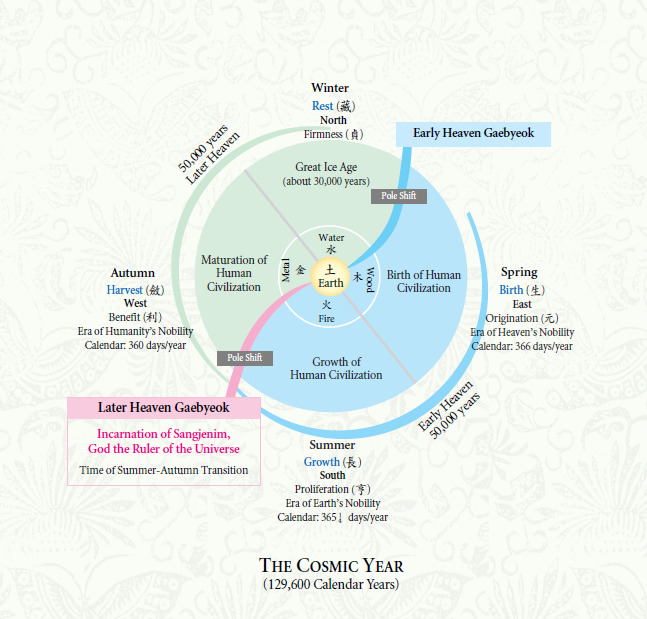|
|
First, what is the Early Heaven Gaebyeok?
[Within the context of a cosmic year,] the Early Heaven Gaebyeok occurs at the beginning of the cosmic spring. In the Early Heaven Gaebyeok, heaven and earth are violently shaken, giving birth to all life including humanity. This provides momentum to the beginning of the cosmic cycle. Human beings, in accordance with the aims of heaven which gave birth to them, scatter across the earth to actualize heaven’s goal. This goal involves growth and development: human beings, born on earth, impel growth and development, hence establishing civilizations and culture. [cultures] This era is characterized by being heaven-centered—that is, humans attain growth and development and establish cultures only by receiving teachings and revelations from heaven, or from God. We in Jeung San Do call this original culture ‘Spirit Teaching culture.’ For these reasons, this heaven-centered period is known as the Era of Heaven’s Nobility.
Why do human beings, all born of a singular heaven, form different cultures and civilizations in each and every region as they grow and develop on earth? Because in the Early Heaven, the qi of all the many regions of earth where humans reside differ from each other, although heaven’s intention remains forever fixed. The earth, which receives the life and qi conferred by heaven, leads human beings to establish unique regional cultures. It is for this reason that each region has different races, languages, and cultures. The tastes and colors of each culture vary depending upon the soil of the concerned region. The ancient Greek, Iraqi, Sumer, and Inca cultures are good examples.
To sum up, the Early Heaven Gaebyeok creates the momentum for heaven and earth to give birth to life in the cosmic spring and hence begin the cycle of a cosmic year.
What is the Later Heaven Gaebyeok?
The Later Heaven Gaebyeok is, literally, the gaebyeok that occurs when the passage of cosmic time progresses through the transition from the Early Heaven to the Later Heaven—when cosmic summer gives way to cosmic autumn. When the cosmic summer alters to autumn, not only the natural environment of the earth where humans reside but also the solar system to which the earth belongs and the whole universe undergo quakes and severe changes. At this time, the Early Heaven’s order, nature, and era, which have dominated heaven and earth, are drastically transformed into the order, nature, and era of the Later Heaven. The Early Heaven Gaebyeok differs from the Later Heaven Gaebyeok in three main ways. First, the Later Heaven Gaebyeok is a huge gaebyeok entailing severe changes. Second, while the Early Heaven Gaebyeok gives birth to life, the Later Heaven Gaebyeok is a human gaebyeok through which numerous lives are taken in an instant and human seeds are selected. Third, the basic order of heaven and earth changes completely from the Early Heaven’s sanggeuk to the Later Heaven’s sangsaeng.
In terms of the first of these differences, why is the Later Heaven Gaebyeok so huge a gaebyeok entailing such severe changes? It is so because yin and yang energies are transposed. The yang energy that has been impelling growth throughout spring and summer transforms completely into yin energy that aims at ending growth and bringing about a return to life’s roots as autumn draws near. As the yin and yang energies are thus transposed, violent changes strike the heaven, earth, sun, and moon. Therefore, unlike the Spring Gaebyeok, when life is born, an enormous gaebyeok occurs. Heaven and earth, nature and humanity, are all shaken and engulfed within a violent vortex of change.
The severity of the changes of the Autumn Gaebyeok can be demonstrated by the straightening of the earth’s axis. At the time of the coming Autumn Gaebyeok, the earth’s axis, which has been slanted 23.5 degrees, is to be straightened. This will constitute a gigantic change. Even a change of merely 0.1 degrees would suffice to spawn tsunamis and earthquakes, creating chaos. Imagine, then, that the axis moves 23.5 degrees at once, straightening—we cannot even imagine the chaos that will be caused by such a shift. Sangjenim revealed that at the coming of this time, some countries [lands] will sink into the sea, while new lands shall rise from the ocean; the three countries in the East (Korea, China, Japan) will become one landmass, and some countries shall disappear without a single survivor.
Next, the Later Heaven Gaebyeok will slay life in a single stroke and select human seeds. While the Early Heaven Gaebyeok in spring gives birth to life, the Later Heaven Gaebyeok in autumn takes all life. In Jeung San Do, we say that the Later Heaven Gaebyeok is the ‘gaebyeok in which human seeds are culled.’ When the Autumn Gaebyeok occurs, only the seeds of those who should live will survive, while multitudes of human beings shall perish like falling leaves. This is a major characteristic of the Autumn Gaebyeok. The Taesang Jongdosanim of Jeung San Do explains this as the principle of birth in spring and death in autumn. Although humans are born in cosmic spring and are raised throughout cosmic summer, the growth process is abruptly brought to a halt in cosmic autumn. Just as the heavy frost of a single autumn morning kills grass at a single stroke, in autumn the autumn energy takes away many lives in a single stroke. ‘Death in autumn’—this is a providence of nature which nobody can oppose. All shall perish in autumn, save for the seeds of humanity selected by heaven and earth. This is why the Later Heaven Gaebyeok is known as ‘the gaebyeok of humanity.’
After all, while the Spring Gaebyeok, or the Early Heaven Gaebyeok, births and nurtures life and cultures, the Later Heaven [Gaebyeok] is a process of grand cosmic change in which those lives and cultures are sorted and harvested. The gaebyeok now approaching humanity is the Autumn Gaebyeok.


 Jeung San Do Terms
Jeung San Do Terms 
 증산도 JeungSanDo (English)
증산도 JeungSanDo (English)